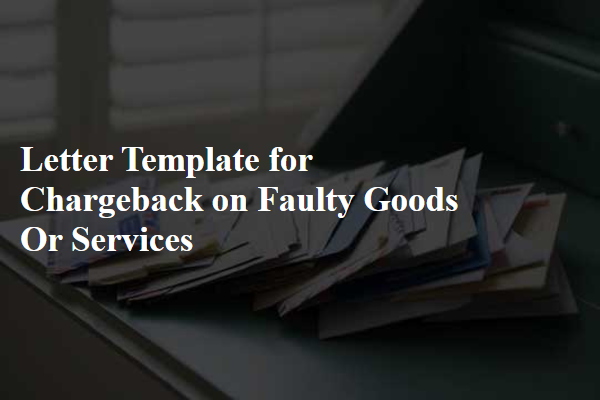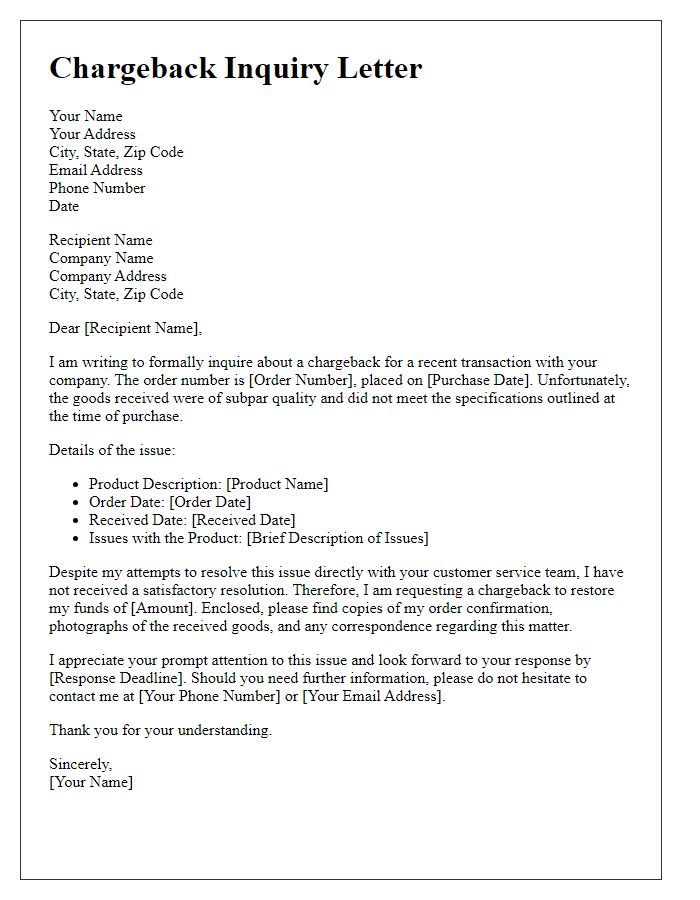Have you ever received a product that didn't live up to its promise or a service that simply fell flat? If so, you're not alone, and the good news is that there are steps you can take to address it. Writing a chargeback letter for faulty goods or services can help you reclaim your hard-earned money and hold companies accountable. Stick around to discover a simple template that makes the process easy and effective!

Clear subject line and recipient details.
A chargeback request for faulty goods or services should include specific elements for clarity and effectiveness. The subject line must clearly indicate the intention, such as "Chargeback Request for Faulty Item - Order #12345." The recipient details should include the name of the customer service department, the company's name (e.g., XYZ Retail Inc.), and any relevant contact address or email (such as service@xyzretail.com) to ensure proper handling. A concise description of the issue, including purchase date (March 1, 2023), item details (e.g., Model Z speaker), and transaction amount ($50.99), must be included. Finally, the request should also mention previous communication related to the problem, referencing any ticket numbers or dates of discussions. This information creates a clear, actionable letter that facilitates the chargeback process.
Detailed description of faulty goods/services.
A chargeback on faulty goods or services typically involves a situation where a product, such as an electronic device or a piece of clothing, does not function as advertised or has defects that make it unusable. For instance, a smartphone purchased from an online retailer may experience significant battery drainage within a few hours of use, indicating potential manufacturing defects that violate consumer rights. Similarly, a designer handbag could arrive with noticeable stitching flaws or color discrepancies, failing to meet quality standards set by the brand. In both scenarios, the customer may initiate a chargeback through their bank or credit card company, citing issues such as misrepresentation, defective materials, or failure to provide services as promised, including inadequate support or warranty coverage. Accurate documentation, including photographs and correspondence with the seller, can bolster this claim and streamline the resolution process.
Relevant purchase and transaction details.
When filing a chargeback for faulty goods or services, it is essential to include specific transaction details to support your claim effectively. Start by documenting the purchase date, which is critical for establishing the timeline. Include the merchant's name and transaction ID for clear identification. Mention the transaction amount and the payment method used, such as credit card details (not the full number for security reasons). Describe the faulty product or service comprehensively, detailing the issues encountered like defects, malfunctions, or unmet service standards. Provide any supporting evidence, such as photographs of the item, correspondence with the merchant, or receipts showing the purchase. Clearly state your attempts to resolve the matter directly with the merchant, including dates and responses received, emphasizing their refusal to address the issue. Lastly, include your contact information for further inquiries and ensure all information adheres to privacy best practices to protect your sensitive data.
Evidence and documentation support.
When initiating a chargeback for faulty goods or services, extensive documentation is crucial. Gather evidence such as transaction receipts, order confirmations, and any correspondence with the seller, illustrating attempts to resolve the issue. Photographs highlighting defects or failures of the product, alongside any warranties or guarantees provided at the point of sale, strengthen the case. Payment details, including credit card statements showing the charge, also serve as essential proof. Relevant policies from payment processors, such as Visa's or MasterCard's guidelines on chargebacks, may provide additional context for the dispute. Collecting this comprehensive evidence ensures a robust foundation for the chargeback process, enhancing the likelihood of a favorable outcome.
Request for resolution or refund.
When consumers encounter faulty goods or services, initiating a chargeback is an important step toward resolution and regaining financial security. In these cases, unresponsive merchants or defective items can significantly impact buyer satisfaction. Chargeback requests can be directed through credit card issuers, such as Visa or Mastercard, which provide consumer protection policies enabling refunds in cases of fraudulent or unsatisfactory transactions. Essential details include transaction dates, amounts, descriptions of the faulty product (like a malfunctioning appliance), and attempts to resolve the issue with the merchant (noted with dates and specific interactions). Documenting all communications with the retailer, including emails and call logs, strengthens the claim's validity. Consumers should file within the specified time frames set by financial institutions, often within 60 days of the transaction, to ensure eligibility.
Letter Template For Chargeback On Faulty Goods Or Services Samples
Letter template of chargeback submission for misleading product description













Comments